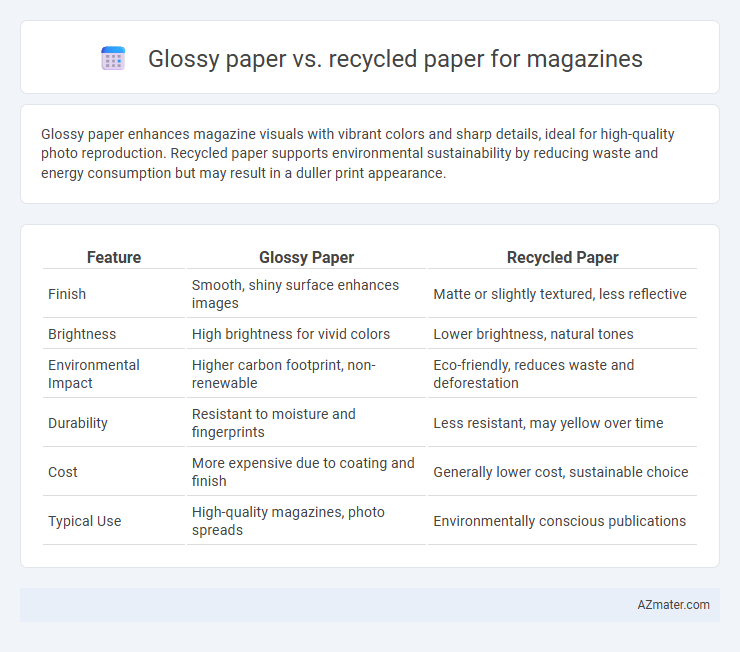Glossy paper enhances magazine visuals with vibrant colors and sharp details, ideal for high-quality photo reproduction. Recycled paper supports environmental sustainability by reducing waste and energy consumption but may result in a duller print appearance.
Table of Comparison
| Feature | Glossy Paper | Recycled Paper |
|---|---|---|
| Finish | Smooth, shiny surface enhances images | Matte or slightly textured, less reflective |
| Brightness | High brightness for vivid colors | Lower brightness, natural tones |
| Environmental Impact | Higher carbon footprint, non-renewable | Eco-friendly, reduces waste and deforestation |
| Durability | Resistant to moisture and fingerprints | Less resistant, may yellow over time |
| Cost | More expensive due to coating and finish | Generally lower cost, sustainable choice |
| Typical Use | High-quality magazines, photo spreads | Environmentally conscious publications |
Introduction to Magazine Paper Choices
Magazine paper choices significantly impact print quality, environmental footprint, and reader experience. Glossy paper offers vibrant color reproduction and sharp image clarity, ideal for high-end magazines with rich visuals. Recycled paper provides a sustainable alternative with a matte finish, appealing to eco-conscious publishers seeking to reduce waste without sacrificing readability.
What is Glossy Paper?
Glossy paper is a high-quality printing substrate characterized by its smooth, shiny surface that enhances color vibrancy and sharpness, making it ideal for magazines with rich imagery and detailed graphics. It is coated with a polymer or clay layer that reflects light, resulting in a polished finish that improves visual appeal and contrast. This type of paper typically weighs between 80 to 150 gsm, offering durability and a premium feel while supporting high-resolution ink absorption.
What is Recycled Paper?
Recycled paper is produced by reprocessing used paper products to reduce environmental impact and conserve natural resources. It consists of fibers recovered from post-consumer or post-industrial waste, minimizing deforestation and energy consumption compared to traditional glossy paper. This sustainable option often features a matte finish and can be specially treated for magazine printing to ensure durability and print clarity.
Print Quality: Glossy vs Recycled
Glossy paper offers superior print quality for magazines with vibrant colors, sharp images, and a smooth, reflective finish that enhances visual appeal. Recycled paper typically has a rougher texture and lower brightness, which can result in muted colors and less sharp details. Brands aiming for high-impact visuals often prefer glossy paper, while eco-conscious publishers balance quality with sustainability using recycled paper options.
Environmental Impact Comparison
Glossy paper used in magazines typically requires more chemical coatings and energy-intensive processes, resulting in higher environmental footprints compared to recycled paper, which minimizes deforestation and reduces landfill waste. Recycled paper production conserves water and energy, emitting fewer greenhouse gases, while glossy paper often involves non-biodegradable finishes that hinder recycling efforts. Choosing recycled paper for magazines significantly lowers carbon emissions and supports sustainable forestry practices, making it the greener option for environmentally conscious publishing.
Cost Differences and Budget Considerations
Glossy paper typically incurs higher costs due to its smooth, coated surface and vibrant print quality, making it ideal for premium magazines but less budget-friendly. Recycled paper offers a more economical option with lower production expenses and environmental benefits, appealing to publishers aiming to reduce overall print costs. Budget considerations often prioritize recycled paper for large print runs, while glossy paper suits magazines with smaller circulation and higher pricing strategies.
Reader Experience and Visual Appeal
Glossy paper enhances magazine reader experience by offering vibrant colors, sharp image quality, and a smooth finish that elevates visual appeal, making photos and graphics more striking. Recycled paper provides a matte texture that can create a more natural and rustic look but may dull colors and reduce image sharpness, potentially diminishing visual impact. Choosing glossy paper prioritizes bold visuals and reader engagement, while recycled paper supports sustainability with a subtler aesthetic.
Durability and Longevity Analysis
Glossy paper offers superior durability for magazines due to its coated surface, which resists moisture, tearing, and fading, enhancing the longevity of printed images and text. Recycled paper, while environmentally friendly, typically has lower resistance to wear and may yellow or degrade faster over time under frequent handling. Choosing glossy paper extends the magazine's lifespan and maintains print clarity, critical for high-quality visual presentations and long-term archival purposes.
Industry Trends and Publisher Preferences
Magazine publishers increasingly favor glossy paper for its vibrant color reproduction and premium finish, which enhances visual appeal and reader engagement. Industry trends highlight a growing shift toward recycled paper driven by sustainability goals, with recycled stock gaining traction for eco-conscious brands despite its typically muted color quality. Balancing print quality and environmental impact, publishers often select recycled glossy paper to align with both aesthetic standards and corporate responsibility initiatives.
How to Choose the Best Paper for Your Magazine
Glossy paper offers vibrant colors and sharp images ideal for magazines emphasizing high-quality visuals, while recycled paper supports eco-friendly values with a natural texture and lower environmental impact. Evaluate your magazine's brand identity, target audience preferences, and budget to determine the best fit, balancing print quality against sustainability goals. Consider print run size and distributor requirements to optimize costs and environmental responsibility.

Infographic: Glossy paper vs Recycled paper for Magazine
 azmater.com
azmater.com